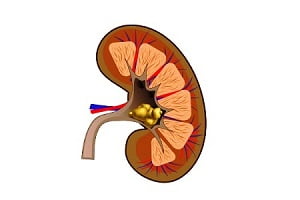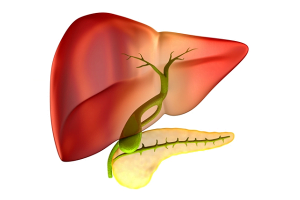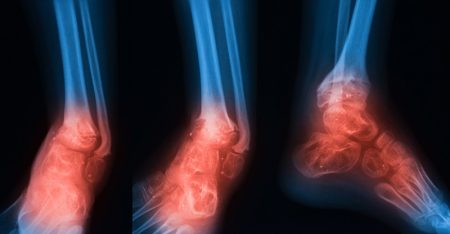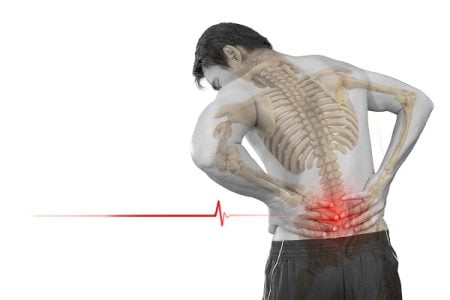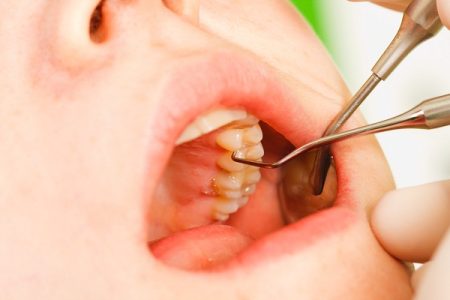What is Osteomyelitis (Bone Infection)?
Osteomyelitis refers to the infection of bone (or bone marrow). In this condition, an inflammation occurs when a bacterial or fungal infection invades the bone tissue. A bone can become infectious in two ways:
- Infection from one part of the body may spread to another part through the bloodstream.
- An open injury or surgery may expose the bone to infection.
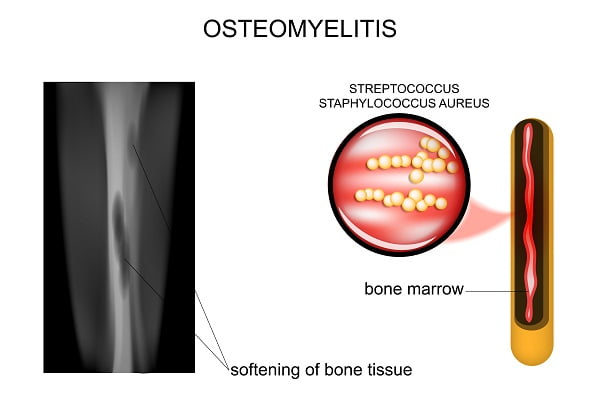
It is a rare but very serious condition. Bone infections can happen suddenly or develop gradually over a long period of time. Bone infections can leave a bone permanently damaged if not treated at the right time.
Occurrence of Osteomyelitis
Osteomyelitis is a rare disease and it affects about two out of every 10,000 people. It can occur to anyone (infants, children, and adults). Different age groups are affected by different kinds of bacteria. This condition affects males more than females.
Osteomyelitis in children and adults
In children, the ends of the arms and legsbones are mostly affected by osteomyelitis. This eventually affects the hips, knees, shoulders, and wrists. In adults, the disease is more common in the bones of the spine, feet and in the pelvis.
What are the Symptoms of Osteomyelitis?
Common osteomyelitis symptoms may include:
- A high temperature of 100.5F or above
- Intense pain and tenderness in the affected area
- Swelling, redness and a warm sensation in the affected area
- Drainage of pus through the skin
- Discomfort and ill feeling
- Weakness
- Sweating
- Chills
- Lower back pain (if affected area involves back)
- Changes in walking pattern (because of pain), yielding a limp
- Stiffness in bones (due to infection)
What are the different types of osteomyelitis?
Broadly, osteomyelitis is classified into three categories:
Acute osteomyelitis
Acute osteomyelitis is a medical term for a new infection in the bone. It occurs predominantly in children. The most common bacterium involved in the infection is Staphylococcus aureus.
The infection develops within 2 weeks of any injury or the start of an underlying disease. The pain that is caused can be intense, and the condition can be life threatening if not taken care of.
Sub-acute osteomyelitis
Infection in sub-acute osteomyelitis develops within 1 to 2 months of an injury or the start of an underlying disease. Infection is accompanied by a mild to moderate pain in the affected area.
Chronic osteomyelitis
Chronic osteomyelitis is the most serious and the third stage infection of the bone. The infection starts within 2 months of an injury or the start of an underlying disease. It is a recurring condition because it is very difficult to treat the chronic osteomyelitis definitively.
What are the causes of osteomyelitis?
Osteomyelitis can be caused by a variety of microbial agents but the most common is Staphylococcus aureus. The infection can be caused by any of the following situations:
Open injury
An open injury to the bone (such as an open fracture) in which the bone ends punctures the skin gets exposed to the bacteria.
Bloodstream
Germs from another part of the body (like in the lungs from pneumonia or in the bladder from urinary tract infection) can spread to any weak point in a bone through the blood.
Blood clot
A minor trauma leading to a blood clot around the bone followed by a secondary infection from the seeding of bacteria.
Chronic wound
A chronic open wound can extend down to the bone surface leading to a secondary bone infection.
Recent surgery
A recent surgery or injection around a bone can expose the bone to bacteria and lead to osteomyelitis.
What are the risk factors of osteomyelitis?
Normally, the bones in the body are resistant to any infection. In osteomyelitis, some situations make the bones vulnerable and increase the likelihood of getting a bone infection. Situations that increase the risk of developing the disease are given below:
Circulation disorders
If blood vessels are damaged, the body is unable to distribute the infection-fighting cells to the site of infection. This makes a small infection to grow larger. In such situations, a small cut can eventually convert into a deep ulcer that exposes the deep tissue and bone to infection. There are certain diseases that impair the blood circulation:
- Diabetes
- Peripheral arterial disease (related to smoking)
- Sickle cell disease
Problems requiring intravenous lines or catheters
Some treatments require the use of medical tubing to connect the outside world with the internal organs. The medical tubing can serve as a way for germs to get into the body, which increases the risk of an infection and can lead to osteomyelitis. The tubing might be used in the following cases:
- Dialysis machine tubing
- Urinary catheters
- Long-term intravenous tubing (also called central lines)
Conditions that impair the immune system
The weak immune system increases the risk of osteomyelitis. Factors that may suppress the immune system include:
- Chemotherapy
- HIV or AIDS
- Poorly controlled diabetes
- Certain medications like corticosteroids or drugs called tumor necrosis factor (TNF) inhibitors
Use of illegal drugs
People who inject illicit drugs generally use non-sterile needles and thus are more likely to develop osteomyelitis. Such people don’t even sterilize their skin before injections.
Diagnosis of osteomyelitis
To diagnose osteomyelitis following steps are taken:
Physical examination
In the first step, a physician looks for signs or symptoms of osteomyelitis like bone tenderness, swelling and redness. The doctor also asks the patient about the personal and family medical history.
Blood tests
Some measurements are taken while testing blood to confirm an infection:
- CBC (complete blood count) – to know if there is an increased white blood cell count.
- ESR (erythrocyte sedimentation rate) – measures inflammation.
- CRP (C-reactive protein) – detects and measures inflammation in the body.
Blood culture
A blood culture is a test used to detect any bacteria in the blood. For this, a sample of blood is taken and is placed in a bacteria-friendly environment (that supports the growth of bacteria). When bacteria grows, the infectious agent can be identified. It is then tested against different antibiotics in order to find the most effective treatment.
Needle aspiration
A sample of fluid and cells are removed from the vertebral space by using a needle. The sample is then sent to the lab for evaluation after the infectious agent is allowed to grow on media.
Biopsy
In this test, a tissue sample is taken from the infected bone and then tested for an invading organism.
Bone scan
During this test, a small amount of a radioactive material (mostly Technetium-99 pyrophosphate) is injected into the body through veins. The radioactive material will spread in a uniform manner if the bone tissue is healthy. However, if the bone is affected by a tumor or bone infection, the material will be absorbed, and an increased concentration of the radioactive material can be seen with a special camera that produces the images on a computer screen.
Treatment of osteomyelitis
The main aim of osteomyelitis treatment is to eliminate the bone infection and prevent the development of chronic infection. If acute osteomyelitis is not treated on time, it gives rise to chronic osteomyelitis, which eventually leads to permanent deformity, possible fractureand chronic problems.
The treatment of osteomyelitis process in following way.
Medications for osteomyelitis
Doctors prescribe antibiotics for people with osteomyelitis. Antibiotics help to get rid of bacteria present in the bloodstream minimizing its chances of re-infecting the bone.
A bone biopsy reveals the type of germs that are causing the infection. The dosage and type of antibiotic depend on the type of bacteria present and the time period of infection. The antibiotics are given intravenously for at least six weeks. For serious infections, an additional course of oral antibiotics is needed.
Prescribed antibiotics are given below:
- Amoxicillin-clavulanate
- Ciprofloxacin
- Levofloxacin
- Moxifloxacin
Surgery for osteomyelitis
A surgery is needed if:
- a build-up of pus (abscess) develops in the bone (which needs to be drained)
- the infection presses against something else (like the spinal cord)
- the infection has damaged the bone (damaged part needs to be removed)
In the case of spinal abscesses, surgery is performed only if there is compression of the spinal cord or nerve roots. In other cases, patients with spinal osteomyelitis are given intravenous antibiotics.
The surgery for osteomyelitis is done as follows.
Drain the infected area
The area around the infected bone is opened and the pus or fluid is drained.
Remove diseased bone and tissue
This process is also known as debridement. The surgeon removes the diseased bone and to ensure that all the infected areas have been removed he takes a small margin of healthy bone too. If the surrounding tissue shows any signs of infection then it is also removed.
Restore blood flow to the bone
Removal of damaged bone leaves an empty space in the bone, which may be packed with antibiotic dressing. In order to repair the area near the affected bone, muscle and skin from another part of the body are used.
If the patient is not healthy enough to undergo a bone or tissue graft, temporary fillers are placed in the pocket until he is ready. The graft helps the body to repair damaged blood vessels and form new bone.
Remove any foreign objects
Foreign objects like surgical plates or screws that were placed during a previous surgery may have to be removed in some cases if they pose a danger.
Amputate the limb
In more serious situations, the affected limb is removed to stop the infection from spreading further.
After surgery, antibiotics (against the bacteria involved in the infection) are given intensively for many weeks to prevent the infection from recurring.
Prevention of osteomyelitis
There are certain steps that can be taken to reduce the chances of developing osteomyelitis.
Avoiding infection
In order to reduce the chance of getting an infection from an injury, wounds should be cleaned thoroughly. It is done by keeping them under a tap of running water for few minutes and then covering the wound with a sterile gauze or clean cloth. In case of severe injury, approaching the nearby hospital is a good idea.
Improving health
Weak immune system or poor circulation attracts infections. Taking steps to improve the general health can reduce your risk of osteomyelitis.
Stop smoking
Smoking cigarette is very harmful to health in general as well, and it also:
- clog the arteries and increase the blood pressure (both of which are bad for your circulation)
- Weaken the immune system
Quitting smoking is the solution to all these problems.
Healthy diet
Unhealthy diet affects our body in a negative way:
- High-fat foods cause a build-up of fatty deposits in the arteries
- Obesity can lead to high blood pressure
To improve the blood circulation and prevent osteomyelitis, doctors suggest a low-fat high-fiber diet, which includes plenty of fresh fruit and vegetables and whole grains.
Eating a healthy diet can also help boost your immune system and also help to maintain weight.
Alcohol
Excessive drinking raises both the blood pressure and cholesterol level. Alcohol should be avoided at any cost. But if avoiding it is not possible then the daily recommended limit should not exceed beyond certain limits. The limits are:
- Three to four units a day for men
- Two to three units a day for women
A unit of alcohol is roughly equal to a single measure (25ml) of spirits.
Regular exercise
Exercise helps to maintain a healthy body. It also helps to:
- Lower the blood pressure
- Make the heart and blood circulatory system more efficient
- Help boost a weak immune system
150 minutes of moderate to vigorous exercise a week is recommended for a healthy mind and body. Beginners can start from 5 to 10 minutes of light exercise a day and then gradually increase the duration and intensity of the activity.
Complications of osteomyelitis
The complications of osteomyelitis may include the following.
Recurring osteomyelitis
If anyone had a previous episode of osteomyelitis, there’s a chance of it returning. This is because conditions that often cause osteomyelitis (such as poor circulation or a weakened immune system) are very difficult to treat.
Gangrene
Gangrene is the condition in which a reduced blood supply to the bone can cause the tissue to die.
Osteonecrosis
An infection in the bone can stop the blood circulation within the bone, which can lead to bone death (osteonecrosis).
A small section of dead bone can heal after the surgery but if a large section of the bone has died, then that limb is surgically removed to prevent the spread of the infection.
Septic arthritis
Sometimes, the infection within bones can spread into a nearby joint.
Impaired growth
In children, osteomyelitis mostly affects the softer areas, called growth plates, at either end of the long bones of the arms and legs. This affects their normal growth.
Skin cancer
If osteomyelitis has resulted in open sore draining pus, the surrounding skin is at higher risk of developing squamous cell cancer (skin cancer).
